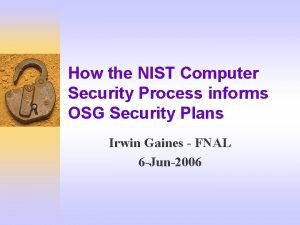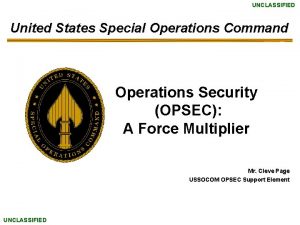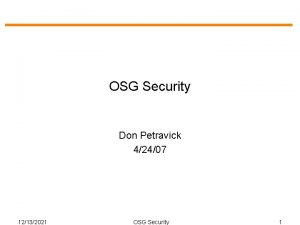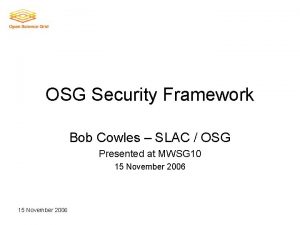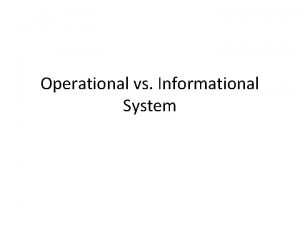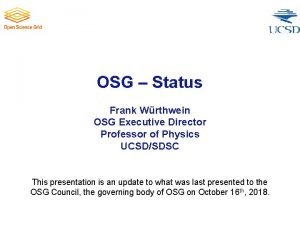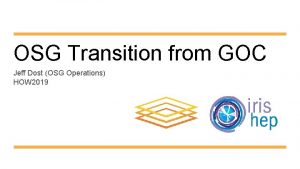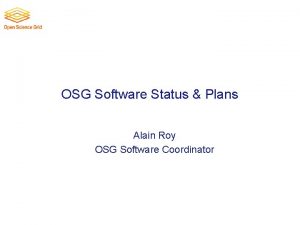OSG Operational Security D Petravick For the OSG














- Slides: 14

OSG Operational Security D. Petravick For the OSG Security Team: Don Petravick, Bob Cowles, Leigh Grundhoefer, Irwin Gaines, Doug Olson, Alain Roy, Vikram Andem EGEE 06 Sept 25, 2006 9/25/08 DLP 1

Background • OSG Project now funded by DOE and NSF as a national production level distributed facility. • Moves on from the Grid 3 -Trillium era as being a relied upon, sustained infrastructure. • As a contributor to the WLCG OSG must satisfy the security requirements of the LHC. • OSG Security is building on prior work of Trillium collaborating with EDG, EGEE, WLCG. 9/25/08 DLP 2

Illustrative example Data I trust it is the VO (or agent) Storage I trust it is the user User 9/25/08 I trust the job is for the VO W W C VO infra. E W W Jobs I trust it is the user’s job W W VO Site DLP W W W 3

OSG Site-VO Interoperation Site VO Perceived Risk Actual Risk? y Perceived Risk n O p e r a t e Actual Risk? y Implement controls 9/25/08 O p e r n a t e DLP 4

Risk based view of the world • Organizations implement controls over their activities so as to obtain acceptable residual risk. Organizations: Sites, VOs and Grids. – Each has a security process lifecycle. – Satisfaction jointly and severally. • Each organization is captain of its own ship. – However, constrained to interoperate. • Standards (e. g. OSG AUP’s) aid interoperation. • OSG will accept agreements from small VOs 9/25/08 DLP their security agent. . 5 and work with them as

Two Broad Documents in the NIST pattern. • Risk Assessment – Analyzes • threats and vulnerabilities • With mitigation in 13 control clusters • To see if the residual risk is acceptable. • Security Plan – Explains each control cluster. – Establishes tests of effectiveness. 9/25/08 DLP 6

(Imagined) Security Assessment – Do you have focus? • Have you written down what is important and what is not (Risk Assessment) – Have you written down your Policies? – Do you have plan? Do you know it is working? (Security Plan) 9/25/08 DLP 7

RA(1) Threats to OSG • • Careless or uninformed authorized person Squatter Vandals Thief Malware Author Spy Alarmist 9/25/08 DLP 8

RA(2)Vulnerabilities • Reliance on Third Parties. – This is a “whopper”. • Improper (core person/user) Actions • Remote Access. • Exploits latent in Vulnerable Software. 9/25/08 DLP 9

RA(3)Impact • Impact to be consistent with LCG T 2 requirements (among others) • The goal is to get to LOW – Occurrence -- Less than 5 x/year – Perception … OSG can be Relied on. – No single occurrence disrupts … all. • Then there are medium and high, but the point of the analysis is to get to low. • How do you get to low? Controls. 9/25/08 DLP 10

SP(1)Controls • Written as if all are in place. • Management – Integrated Sec Mgt; Sec processes; Trust Relationships & Agreements • Operational – Awareness; Response; Data Integrity; Config Management; Vul. ID; Physical • Technical – Monitoring; Scanning; Control of people 9/25/08 DLP 11

SP(2)Draft Cluster -- Vul. Mgt. • • • General Vulnerability Reporting Primary Vulnerability Reporting Secondary Vulnerability Awareness Vulnerability Mitigation Vulnerability Communication Vulnerability Awareness 9/25/08 DLP 12

(SP 3)DRAFT Primary Vulnerability Reporting • Plan: • … entities operating a service or running a process for the OSG have primary responsibility for identifying vulnerabilities. • … requires services and processes to report vulnerabilities inconsistent with acceptable risk to the OSG security officer. Acceptable risk is defined in the OSG Risk Assessment. • Evaluation • This control is evaluated annually by an inspection of the vulnerabilities logs – Comparing the primary reports to reports from the secondary chain. – Comparing the primary reports to vulnerabilities exploited in incidents. 9/25/08 DLP 13

Summary • Security interoperation is required for grid interoperation. – – Without work, interoperation is n**2 agreements. Each organization must satisfy its self-identified security needs. Common policies (such as the user AUP) speed up the n**2 process. In the OSG, VO’s with heavy infrastructure seem to face diligence approximately equal to a site. – We are hear to learn about EGEE. – One way forward which may provide maximum interoperation and scaling seems to be to agree on Control Clusters, and then drill down. • OSG has begun writing plans in a structure based on an understanding of NIST. • OSG is working with the Site and VO Managers to clarify and collaborate on Security matters (as well as with EGEE and Tera. Grid). DLP 9/25/08 14
 Private security
Private security Osg architecture
Osg architecture Osg walk in
Osg walk in Nsdd 298
Nsdd 298 Mästare lärling modell
Mästare lärling modell Stål för stötfångarsystem
Stål för stötfångarsystem Centrum för kunskap och säkerhet
Centrum för kunskap och säkerhet Underlag för särskild löneskatt på pensionskostnader
Underlag för särskild löneskatt på pensionskostnader Verktyg för automatisering av utbetalningar
Verktyg för automatisering av utbetalningar Vishnuismen
Vishnuismen Jag har gått inunder stjärnor text
Jag har gått inunder stjärnor text Exspektans eller expektans
Exspektans eller expektans Boverket ka
Boverket ka Strategi för svensk viltförvaltning
Strategi för svensk viltförvaltning Verksamhetsanalys exempel
Verksamhetsanalys exempel


